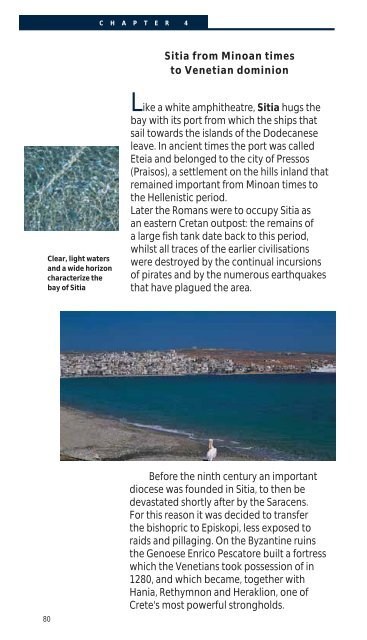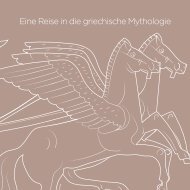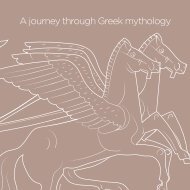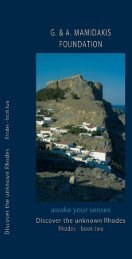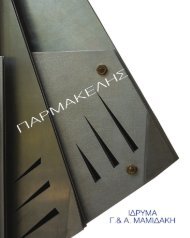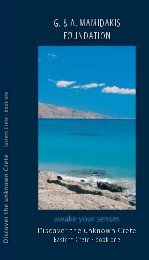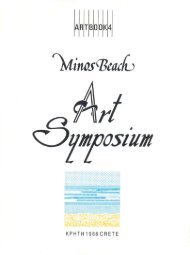Crete-Discover the Unknown Crete
Ένας πλούσια εικονογραφημένος, πρακτικός οδηγός που αναδεικνύει περισσότερο ή λιγότερο άγνωστα σημεία και αξιοθέατα της ανατολικής Κρήτης. Με το βιβλίο αυτό ανά χείρας, ο επισκέπτης έχει την ευκαιρία να επισκεφθεί αρχαιολογικούς χώρους, μοναστήρια, χωριά και φαράγγια και να πάρει μια πιο αυθεντική γεύση της σχετικά ανεξερεύνητης αυτής πλευράς της Κρήτης. Κείμενα: Judith Lange Φωτογραφία: Judith Lange, Μαρία Στέφωση Σχεδιασμός και καλλιτεχνική επιμέλεια: Μαρία Στέφωση Μετάφραση: Julia MacGibbon Επιμέλεια δοκιμίων: John o'Shea Εκτύπωση και βιβλιοδεσία: Γραφικές Τέχνες Δετοράκης ΑΕΒΕ ISBN: 978-960-98384-3-6
Ένας πλούσια εικονογραφημένος, πρακτικός οδηγός που αναδεικνύει περισσότερο ή λιγότερο άγνωστα σημεία και αξιοθέατα της ανατολικής Κρήτης. Με το βιβλίο αυτό ανά χείρας, ο επισκέπτης έχει την ευκαιρία να επισκεφθεί αρχαιολογικούς χώρους, μοναστήρια, χωριά και φαράγγια και να πάρει μια πιο αυθεντική γεύση της σχετικά ανεξερεύνητης αυτής πλευράς της Κρήτης.
Κείμενα: Judith Lange
Φωτογραφία: Judith Lange, Μαρία Στέφωση
Σχεδιασμός και καλλιτεχνική επιμέλεια: Μαρία Στέφωση
Μετάφραση: Julia MacGibbon
Επιμέλεια δοκιμίων: John o'Shea
Εκτύπωση και βιβλιοδεσία: Γραφικές Τέχνες Δετοράκης ΑΕΒΕ
ISBN: 978-960-98384-3-6
You also want an ePaper? Increase the reach of your titles
YUMPU automatically turns print PDFs into web optimized ePapers that Google loves.
C H A P T E R 4<br />
Sitia from Minoan times<br />
to Venetian dominion<br />
Clear, light waters<br />
and a wide horizon<br />
characterize <strong>the</strong><br />
bay of Sitia<br />
Like a white amphi<strong>the</strong>atre, Sitia hugs <strong>the</strong><br />
bay with its port from which <strong>the</strong> ships that<br />
sail towards <strong>the</strong> islands of <strong>the</strong> Dodecanese<br />
leave. In ancient times <strong>the</strong> port was called<br />
Eteia and belonged to <strong>the</strong> city of Pressos<br />
(Praisos), a settlement on <strong>the</strong> hills inland that<br />
remained important from Minoan times to<br />
<strong>the</strong> Hellenistic period.<br />
Later <strong>the</strong> Romans were to occupy Sitia as<br />
an eastern Cretan outpost: <strong>the</strong> remains of<br />
a large fish tank date back to this period,<br />
whilst all traces of <strong>the</strong> earlier civilisations<br />
were destroyed by <strong>the</strong> continual incursions<br />
of pirates and by <strong>the</strong> numerous earthquakes<br />
that have plagued <strong>the</strong> area.<br />
80<br />
Before <strong>the</strong> ninth century an important<br />
diocese was founded in Sitia, to <strong>the</strong>n be<br />
devastated shortly after by <strong>the</strong> Saracens.<br />
For this reason it was decided to transfer<br />
<strong>the</strong> bishopric to Episkopi, less exposed to<br />
raids and pillaging. On <strong>the</strong> Byzantine ruins<br />
<strong>the</strong> Genoese Enrico Pescatore built a fortress<br />
which <strong>the</strong> Venetians took possession of in<br />
1280, and which became, toge<strong>the</strong>r with<br />
Hania, Rethymnon and Heraklion, one of<br />
<strong>Crete</strong>'s most powerful strongholds.


